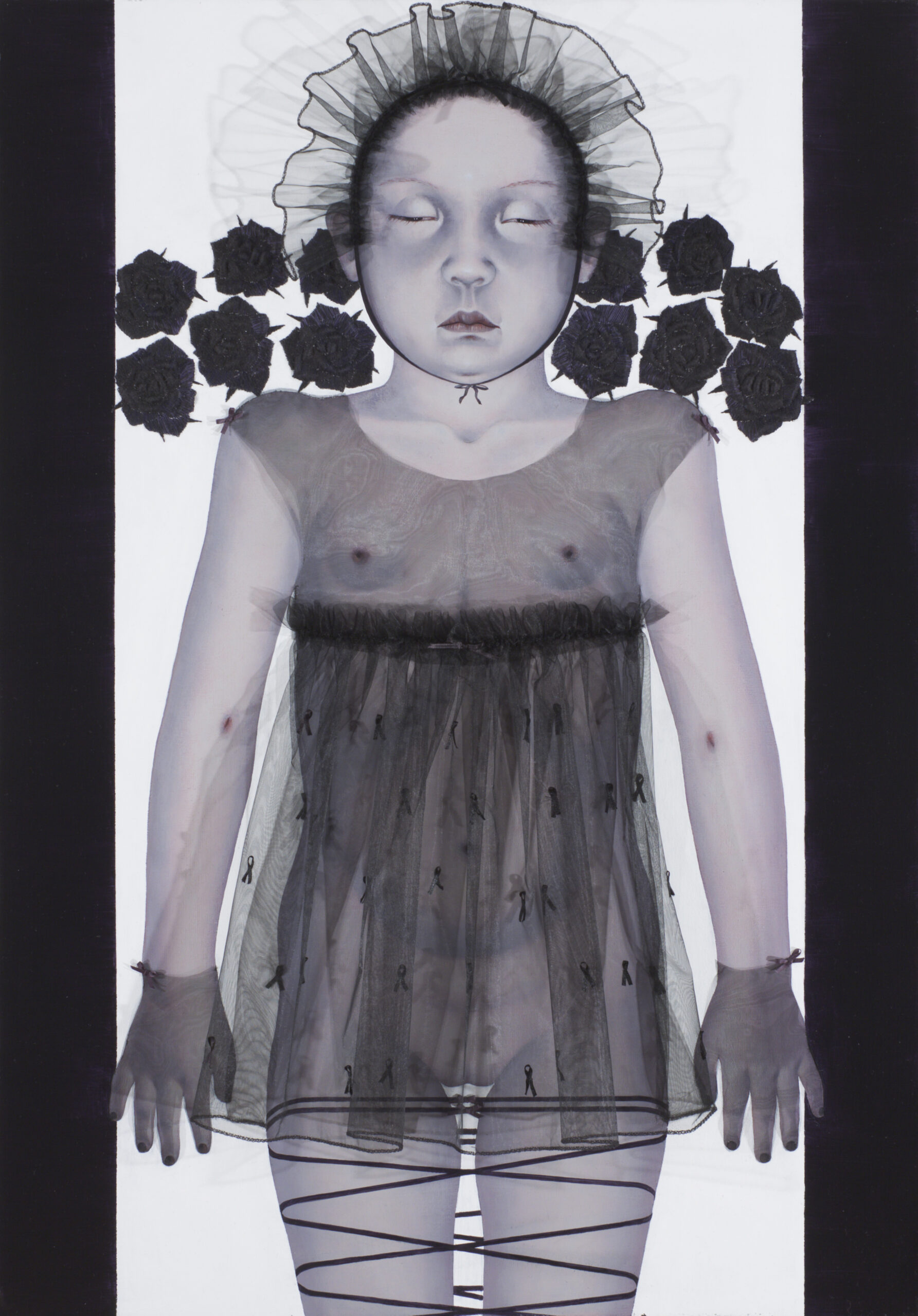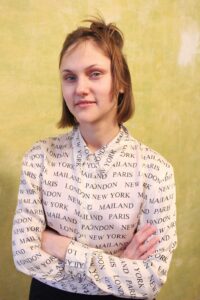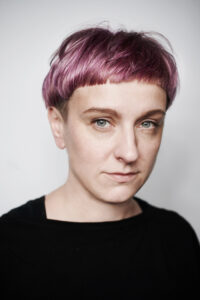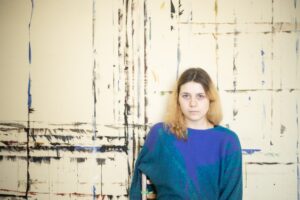Beata Ewa Białecka
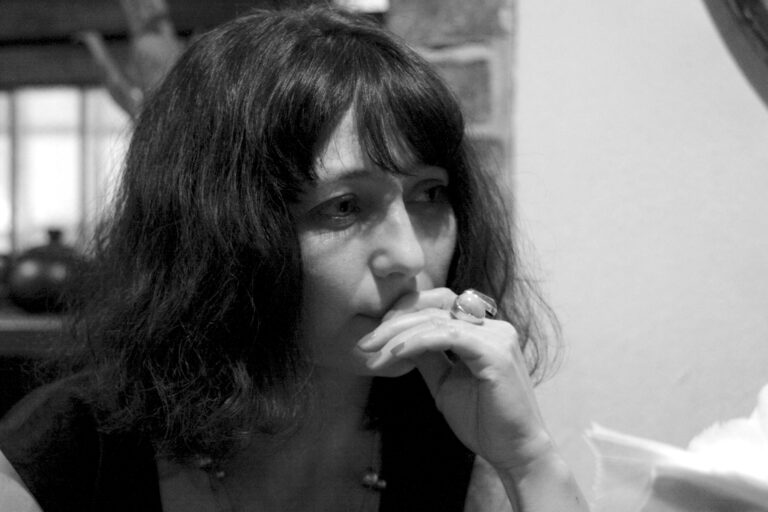
– born 1966 in Mikołów. Is a graduate of the Faculty of easel painting at the Academy of Fine Arts in Krakow. In 1992, she obtained her diploma in the studio of Professor Jerzy Nowosielski. She was awarded the golden badge Primus Inter Pares of the Academy of Fine Arts in Krakow (1992), is a laureate of, among others, New Tendencies in Polish Painting 2 (2011), Grand Prix of the Minister of Culture and National Heritage of the 6th Triennial of Sacrum “Art against Evil” (2006) and Grand Prix of the Minister of Culture and National Heritage of the 6th Triennial of Sacrum “Art against Evil (2006) and the Grand Prix of the Minister of Culture and National Heritage of the 21st Festival of Contemporary Polish Painting (2006). She is the author of several dozen solo and group exhibitions, and her works are in a number of significant collections of contemporary art in Poland and abroad.
Painting.
I learned to love painting at an early age, following my mother’s compulsive addiction to painting (beauty), a poor lesson that brought me more pain than satisfied hunger (beauty) later in life. I have been a painter for as long as I can remember. I do the same service every day on my way to school, I walk down slowly – there are oil paintings or reproductions hanging on the walls of the staircase – I look at them, stop as if I were at a station, my hand marking out the brush stroke. I am 7 or 8 years old at most and I think I can do it too.
The natural course of things was an art school. Without difficulty I passed the exam to the only Artistic Weaving School in Poland in Zakopane (1981). The school was established for highland girls by the famous actress Helena Modrzejewska in 1883. When my mother enrolled me almost 100 years later, she showed the school principal my winning diplomas from national painting contests for elementary schools. In elementary school, under the supervision of Madam Maria – an older lady, a graduate of the Academy of Fine Arts in Krakow – I painted in the afternoon common room. She was the one to send my works to children’s competitions. She singled me out from the herd, individualized me, and praised uniformd my school apron, the only non-iron one, beautifully embroidered with a lace starch collar, so different that it provoked lively polemics among teachers in the times of real socialism. I grew, and Mom sewed another one, different from the rest. Thanks to my mother and Maria, I became a painter. This is an identity trait. The Academy of Fine Arts was just a supplement. After returning to painting, after a time of difficult motherhood, I treat being a painter also as a profession. I feel more confident with this thought.
My work is a continuous process, the last image usually implies the creation of another. I am inspired by women, femininity, religious iconography and a woman’s place in it; my artistic strategy is to consciously equalize the image opportunities for women. I feminize religious iconography, I turn male saints into female saints. Didn’t I say that femininity engages everything? Did I not declare that there is nothing in the universe superior to exquisite femininity? (Walt Whitman). Two Maries (2005) on the lap of one of them a child, a girl, Emmanuel becomes Emmanuelle, I use a similar procedure in Samotrzec of 20111 , particularly emphasizing the Marilynar relationships between women. Two Eves (2006) is a canvas where the second Eve appears instead of Adam, The Good Shepherd (2007)2 is a woman with a lamb on her shoulders. A contemporary, cultural touch is the EU-imposed badges clipped into the lamb’s ears. Infanta Fransisca (2008)3 is, in my edit, a woman who, like Christ, stretches her arms across the beam of the cross. A second possible exegesis of the painting is the reference to the medieval depiction of the crucified Wilgefortis, the legendary Brave Virgin, Saint Liberata, who by the power of prayer becomes like Christ. Priestess (2017)4 raises her hands over the altar, taking on a role assigned only to a man. Nausea (2014) is a woman who provokes vomiting like Andżela in Masłowska’s book. Vomiting is her truth, a lyrical image of distaste and disappointment. Disappointment related to being a mother. At all costs she tries to ‘return’ the divine element. In 2007 I painted Two Mothers and in 2018 Balneum, two mothers in the bath, one of them holding a baby in her arms like the Good Shepherd holds a lamb. Two Mothers and Balneum are my disagreement with the impossibility of legalizing civil partnerships in Poland
From 2013-2019 I am painting Acupunctures or ‘pierced paintings’ with a much smaller format, adapted for sitting. It is difficult for me to stand at my easel for hours on crutches, and then after my fifth surgery with an endoprosthesis. I focus on the detail as never before, my hands are hungry for accuracy (E. Bishop). According to Lacan, grasping at the detail is a way of dealing with disintegration. I understand this. Meanwhile, the painting loom becomes an embroidery loom. Embroidery is a kind of meditative, repetitive activity, drained of emotion, soothing both pain and nerves. The punctured canvases refer to suffering, are deeply eschatological (Must Have. My Son’s Feet) or Filiae/Daughters. In 2015 I am painting Narcissus – a kneeling woman over a mirror embroidered with silver thread5. This is one of many paintings where, by feminizing iconography in a subversive way, I replace the previous visual order, this time linked to Greek myth.
I take part in the exhibition “Illness as a source of art” at the National Museum in Poznań. Being ill makes sense. I am lying immobilized for the 4th month already, this time the spine. Out of pain I beg for euthanasia. I already know that in an illness a person is closest to himself, feels one with himself, not only feels that it is him/her but also knows that it is him/her, and even can no longer not know that it is him/her. For suffering is not only pain, but also knowledge. (W. Myśliwski. “Palace”)
Zbigniew Herbert in his poem “Mr. Cogito Rozmyśla o cierpieniu” says that one should create a thing or a person out of the matter of suffering (…) I create persons. Venus (2016)6 wants to return ‘to form’. She is doing an exercise that I myself have not been able to do for a very long time. I paint Motherhood, Dolorosa (2013-2016)7 with hearts embroidered centrally, a symbol truly sacred to all humanity, the Filiae/Daughters series (2015-2018)8. Grey, frozen bodies dressed in transparent dresses of organza or peacock feathers (the cry of the peacock heralds death), I embroider black roses around the heads. I paint a daughter and dress her in a coffin, push her “to the other side”, perform Rosalia – an ancient Roman rite of passage. All paintings are created from the matter of suffering. From the matter of life. I am the type of a woman-mother who had to cope with the illness of her first child and the loss of the second one on her own. That is why I could return to my “profession” only 11 years after graduation. I fully surrendered to fate, motherhood, I did not fight for creative autonomy. At the same time, my husband, also an artist, was just before his post-PhD thesis…
Painting not only calculates my day, it gives it meaning. With paintings I count down my life, I hide myself in them, but I also feel that there is less of me by each painting. Woman, femininity are words that are the exegesis of my painting. Similarly, holiness, motherhood, eschatology. We live in a culture of remix, shifting contexts, cultural cannibalism, intertextuality, collage. I believe that in art everything that is not one’s own discovery gets old quickly, languishes. I try to remove what comes from custom, routine, it is the only way to touch the essence of things. The backgrounds of my paintings describe women’s bodies, they are aristocratic, flattened on purpose in order to free the form, elevate it, make it more beautiful, sometimes even sacralized by putting on “shirts”. It can be called classical in form, but in idea it fits into the current cultural time. I use parabolas, introduce symbolic forms, take characters out of their familiar context. I combine contemporary iconosphere with religious iconography, usually Christian. I emphasize the relationship between two worlds – popular culture and the so-called high art. Thanks to this, the paintings have a cultural memory and the memory of recent times. All the words, slogans – (Thank God I’m a woman, Intimissimi, be-inspired, let’s everybody be mystique, Top secret, etc.), which I introduce into the picture, have an important role to play, they have to support the picture, its sense, so that the worlds of sacrum and profanum have a chance to communicate. I thus draw attention to the fact that we are completely immersed in consumer culture. The last slogan I appropriated while shopping at Rossman’s is Must Have (2015-2018), or “you must have it,” these images are a question about the suffering associated with the desire to have something – we live in abundance and thus constant insatiability – but also with suffering in general, as a condition for knowing life in all its fullness..
Painting is a religious experience for me, the only religious experience at the moment. When I paint, my conscience is clear.
Text was written in collaboration with Karolina Maria Rojek (2020).
1Image: Beata Ewa Białecka, Virgin with Child and St. Anne, 2011, oil on canvas, embroidery, 150 x 150 cm, collection CCA Torun. Courtesy of the artist and CCA Torun.2Image: Beata Ewa Białecka, Dobry Pasterz [Good Shepherd], 2007, oil on canvas, 150 x 100 cm. Courtesy of the artist.
3Image: Beata Ewa Białecka, Franciszka Infanta, 2008, oil on canvas, 150 x 150 cm. Courtesy of the artist.
4Image: Beata Ewa Białecka, Kapłanka [Pristes], 2018, oil on canvas, embroidery with golden thread, beads, 70 x 100 cm. Courtesy of the artist.
5Image: Beata Ewa Białecka, Narcyz [Narcissus], 2015, oil on canvas, embroidery with silver thread, 120 x 150 cm. Courtesy of the artist.
6Image: Beata Ewa Białecka, Ja Wenus [I Venus], 2016, oil on canvas, 120 x 160 cm. Courtesy of the artist.
7Image: Beata Ewa Białecka, Dolorosa, 2014, oil on canvas, embroidery. Courtesy of the artist.
8Image: Beata Ewa Białecka, Filiae, 2015-18, oil on canvas, embroidery, from a series of paintings-images dressed in a coffin. Courtesy of the artist.
– urodzona w 1966 w Mikołowie. Jest absolwentką Wydziału Malarstwa Sztalugowego Akademii Sztuk Pięknych w Krakowie. W 1992 uzyskała dyplom w pracowni prof. Jerzego Nowosielskiego. Została nagrodzona złotą odznaką Primus Inter Pares ASP w Krakowie (1992), jest laureatką m.in. Nowych Tendencji w Malarstwie Polskim 2 (2011), Grand Prix Ministra Kultury i Dziedzictwa Narodowego 6. Triennale Sacrum „Sztuka wobec zła” (2006) oraz Grand Prix Ministra Kultury i Dziedzictwa Narodowego 21. Festiwalu Współczesnego Malarstwa Polskiego (2006). Jest autorką kilkudziesięciu wystaw indywidualnych i zbiorowych, a jej prace znajdują się w kilku znaczących kolekcjach sztuki współczesnej w kraju i za granicą.
Malarstwo.
Malarstwo nauczyłam się kochać już we wczesnym dzieciństwie, za moją mamą, która nałogowo uzależniona jest od obrazu (piękna), to słaba lekcja, która w późniejszym życiu przyniosła mi więcej bólu niż zaspokojenia głodu (piękna). Malarką jestem, odkąd sięgam pamięcią. Codziennie idąc do szkoły odprawiam to samo nabożeństwo, schodzę wolno w dół – na ścianach klatki schodowej wiszą obrazy olejne bądź reprodukcje – przyglądam się, zatrzymuję jak przy stacjach, ręka sama wyznacza dukt pędzla. Mam 7 góra 8 lat i myślę, że też tak potrafię.
Naturalną koleją rzeczy była szkoła artystyczna. Bez trudu zdałam egzamin do jedynego wówczas w Polsce Technikum Tkactwa Artystycznego w Zakopanem (1981 r.). Szkołę utworzyła dla góralskich dziewcząt znana aktorka – Helena Modrzejewska w 1883 roku. Mama, niemalże 100 lat później zapisując mnie, pokazała dyrektorowi szkoły moje zwycięskie dyplomy z ogólnopolskich konkursów malarskich dla szkół podstawowych. W podstawówce pod okiem pani Marii – starszej pani, absolwentki ASP w Krakowie – malowałam w popołudniowej świetlicy. To ona wysyła moje prace na dziecięce konkursy. Wypojedyńcza mnie ze stada, indywidualizuje, pochwala mój szkolny fartuszek, jedyny nie nonajronowy, pięknie wyhaftowany z koronkowym, krochmalonym kołnierzykiem, tak inny, że w czasach realnego socjalizmu wywołuje żywą polemikę wśród nauczycieli. Rosnę, a mama szyje kolejny, inny od reszty. Dzięki mamie i pani Marii zostałam malarką. To cecha tożsamościowa. Akademia Sztuk Pięknych była jedynie uzupełnieniem. Po powrocie do malarstwa, po czasie trudnego macierzyństwa traktuję bycie malarką również jako zawód. Czuję się pewniej z taką myślą.
Praca moja to proces ciągły, ostatni obraz zwykle implikuje powstanie kolejnego. Inspiruje mnie kobieta, kobiecość, religijna ikonografia i miejsce kobiety w tejże, artystyczną strategią jest świadome wyrównywanie szans wizerunkowych kobiet. Feminizuję religijną ikonografię, zamieniam świętych męskich w święte kobiety. Czyż nie powiedziałem, że kobiecość angażuje wszystko? Czyż nie orzekłem, że we wszechświecie nie ma nic przewyższającego znakomitą kobiecość? (Walt Whitman). Dwie Marie (2005) na kolanach jednej z nich dzieciątko, dziewczynka, Emmanuel staje się Emmanuelą, podobny zabieg stosuję w Samotrzeć z 2011 roku1, szczególnie akcentując marylinearne związki między kobietami. Dwie Ewy (2006) to płótno, na którym miast Adama pojawia się druga Ewa, Dobry Pasterz (2007)2 jest kobietą z barankiem na ramionach. Współczesny, kulturowy akcent to narzucone przez UE identyfikatory wpięte w uszy baranka. Franciszka Infanta (2008)3 to w mojej redakcji kobieta, która niczym Chrystus rozpina ramiona na belce krzyża. Drugą możliwą egzegezą obrazu jest odniesienie do średniowiecznego przedstawienia ukrzyżowanej Wilgefortis, legendarnej Dzielnej Dziewicy, Świętej Liberaty, która mocą modlitwy upodabnia się do Chrystusa. Kapłanka (2017)4 wznosi ręce nad ołtarzem, przejmując rolę wyznaczoną jedynie mężczyźnie. Mdłości (2014) to kobieta prowokująca wymioty niczym Andżela u Masłowskiej. Wymioty są jej prawdą, lirycznym obrazem niesmaku i rozczarowania. Rozczarowania związanego z byciem matką. Za wszelką cenę usiłuje ‘zwrócić’ boski pierwiastek. W 2007 roku maluję Dwie Matki, a w 2018 Balneum czyli dwie matki w kąpieli, jedna z nich trzyma dziecko na ramionach niczym Dobry Pasterz baranka. Dwie Matki i Balneum są moją niezgodą na brak możliwości legalizacji związków partnerskich w Polsce.
W latach 2013-2019 maluję Akupiktury czyli ‘przekłuwane obrazy’ o zdecydowanie mniejszym formacie, przystosowanym do pracy w pozycji siedzącej. Trudno jest mi przez wiele godzin stać przy sztaludze o kulach, a potem po piątej operacji z endoprotezą. Skupiam się na detalu, jak nigdy dotąd moje ręce głodne są dokładności (E. Bishop). Wg. Lacana uchwycenie się szczegółu to sposób radzenia sobie z rozpadem. Rozumiem to. Tymczasem krosno malarskie staje się krosnem hafciarskim. Haft to rodzaj medytacyjnej, powtarzalnej czynności, wyprutej z emocji, kojącej i ból, i nerwy. Nakłuwane płótna odnoszą się do cierpienia, są głęboko eschatologiczne (Must Have. Stopy mojego syna) czy Filiae/Córki. W 2015 maluję Narcyza – klęczącą kobietę nad haftowanym srebrną nicią lustrem5. Jest to jeden z wielu obrazów, gdzie feminizując ikonografię w sposób subwersywny, zamieniam dotychczasowe porządki wizualne tym razem powiązane z greckim mitem.
Biorę udział w wystawie „Choroba jako źródło sztuki” w Muzeum Narodowym w Poznaniu. Chorowanie nabiera sensu. Leżę unieruchomiona już 4 miesiąc, tym razem kręgosłup. Z bólu błagam o eutanazję. Wiem już, że w chorobie człowiek jest najbliżej siebie, czuje się jedną ze sobą osobą, nie tylko czuje, że to on, ale także wie, że to on, a nawet nie potrafi już nie wiedzieć, że to on. Bo cierpienie jest nie tylko bólem, lecz i wiedzą. (W. Myśliwski. „Pałac”)
Zbigniew Herbert w wierszu „Pan Cogito rozmyśla o cierpieniu” mówi, że należy stworzyć z materii cierpienia rzecz albo osobę (…) Stwarzam osoby. Ja Wenus (2016)6 chce wrócić ‘do formy’. Robi ćwiczenie, którego ja sama bardzo długo nie byłam w stanie wykonać. Maluję Macierzyństwa, Dolorosy (2013-2016)7 z wyhaftowanymi centralnie sercami, symbolem prawdziwie świętym dla całej ludzkości, cykl Filiae/Córki (2015-2018)8. Szare, zastygłe ciałka ubrane w transparentne sukienki z organzy lub pawich piór (krzyk pawia zwiastuje śmierć), wokół głów haftuję czarne róże. Maluję córkę i ubieram ją do trumny, przepycham „na drugą stronę”, odprawiam Rosalia – starorzymski rytuał przejścia. Wszystkie obrazy powstają z materii cierpienia. Z materii życia. Jestem typem kobiety-matki, która z chorobami pierwszego dziecka i utratą drugiego musiała poradzić sobie sama. Dlatego do „zawodu” mogłam powrócić dopiero 11 lat po studiach. W pełni poddałam się losowi, macierzyństwu, nie walczyłam o autonomię twórczą. W tym samym czasie mąż mój, również artysta był tuż przed habilitacją…
Malarstwo nie tylko kalkuluje mój dzień, nadaje mu sens. Obrazami odliczam życie, ukrywam się w nich, ale też czuję, że o każdy obraz jest mnie mniej. Kobieta, kobiecość to słowa, które są egzegezą mojego malarstwa. Podobnie świętość, macierzyństwo, eschatologia. Żyjemy w kulturze remiksu, przesuwania kontekstów, kulturowego kanibalizmu, intertekstualizmu, kolażowości. Uważam, że w sztuce wszystko to, co nie jest własnym odkryciem, szybko się starzeje, marnieje. Staram się usuwać to, co pochodzi ze zwyczaju, rutyny, to jedyna droga by dotknąć istoty rzeczy. Tła moich obrazów opisują ciała kobiet, są arcyproste, wypłaszczone celowo po to, by uwolnić formę, uwznioślić ją, uhieratycznić, czasem nawet sakralizować poprzez nałożenie „koszulek”. Można je nazywać klasycznym w formie, jednak w idei wpisuje się w obecny kulturowy czas. Stosuję parabole, wprowadzam formy symboliczne, wytrącam postaci ze znanego dotąd kontekstu. Łączę współczesną ikonosferę z ikonografią religijną, najczęściej chrześcijańską. Akcentuję relacje dwóch światów – kultury popularnej i tak zwanej sztuki wysokiej. Dzięki temu obrazy te mają pamięć kulturową i pamięć czasów najnowszych. Wszystkie słowa, slogany – (Thank God I’m a woman, Intimissimi, be-inspired, let’s everybody be mistique, Top secret, etc.), które wprowadzam do obrazu, mają ważną rolę do spełnienia, muszą wesprzeć obraz, jego sens, tak, by światy sacrum i profanum miały szansę się skomunikować. Zwracam uwagę tym samym na fakt, że jesteśmy całkowicie zanurzeni w kulturze konsumpcyjnej. Ostatni slogan, który zawłaszczyłam przy okazji zakupów w Rossmanie, to Must Have (2015-2018), czyli „musisz to mieć”, obrazy te są pytaniem o cierpienie związane z pragnieniem posiadania czegoś – żyjemy w obfitości a tym samym ciągłego nienasycenia – ale i z cierpieniem w ogóle, jako warunkiem poznania życia w całej jego pełni.
Malarstwo jest dla mnie doświadczeniem religijnym, jedynym doświadczeniem religijnym na chwilę obecną. Kiedy maluję, sumienie mam czyste.
Tekst powstał we współpracy z Karoliną Marią Rojek (2020).
1Zdjęcie: Beata Ewa Białecka, Samotrzeć, 2011, olej na płótnie, haft, 150 x 150 cm, kolekcja CSW Toruń. Dzięki uprzejmości artystki i CSW Toruń.2Zdjęcie: Beata Ewa Białecka, Dobry Pasterz, 2007, olej na płótnie, 150 x 100 cm. Dzięki uprzejmości artystki.
3Zdjęcie: Beata Ewa Białecka, Franciszka Infanta, 2008, olej na płótnie, 150 x 150 cm. Dzięki uprzejmości artystki.
4Zdjęcie: Beata Ewa Białecka, Kapłanka, 2018, olej na płótnie, haft kładziony złotą nicią, koraliki, 70 x 100 cm. Dzięki uprzejmości artystki.
5Zdjęcie: Beata Ewa Białecka, Narcyz, 2015, olej na płótnie, haft kładziony srebrną nicią, 120 x 150 cm. Dzięki uprzejmości artystki.
6Zdjęcie: Beata Ewa Białecka, Ja Wenus, 2016, olej na płótnie, 120 x 160 cm. Dzięki uprzejmości artystki.
7Zdjęcie: Beata Ewa Białecka, Macierzyństwo, 2014, olej na płótnie, haft, 100 x 70 cm. Dzięki uprzejmości artystki.
8Zdjęcie: Beata Ewa Białecka, Filiae, 2015-18, olej na płótnie, haft, z cyklu obrazów-wizerunków ubieranych do trumny. Dzięki uprzejmości artystki.
